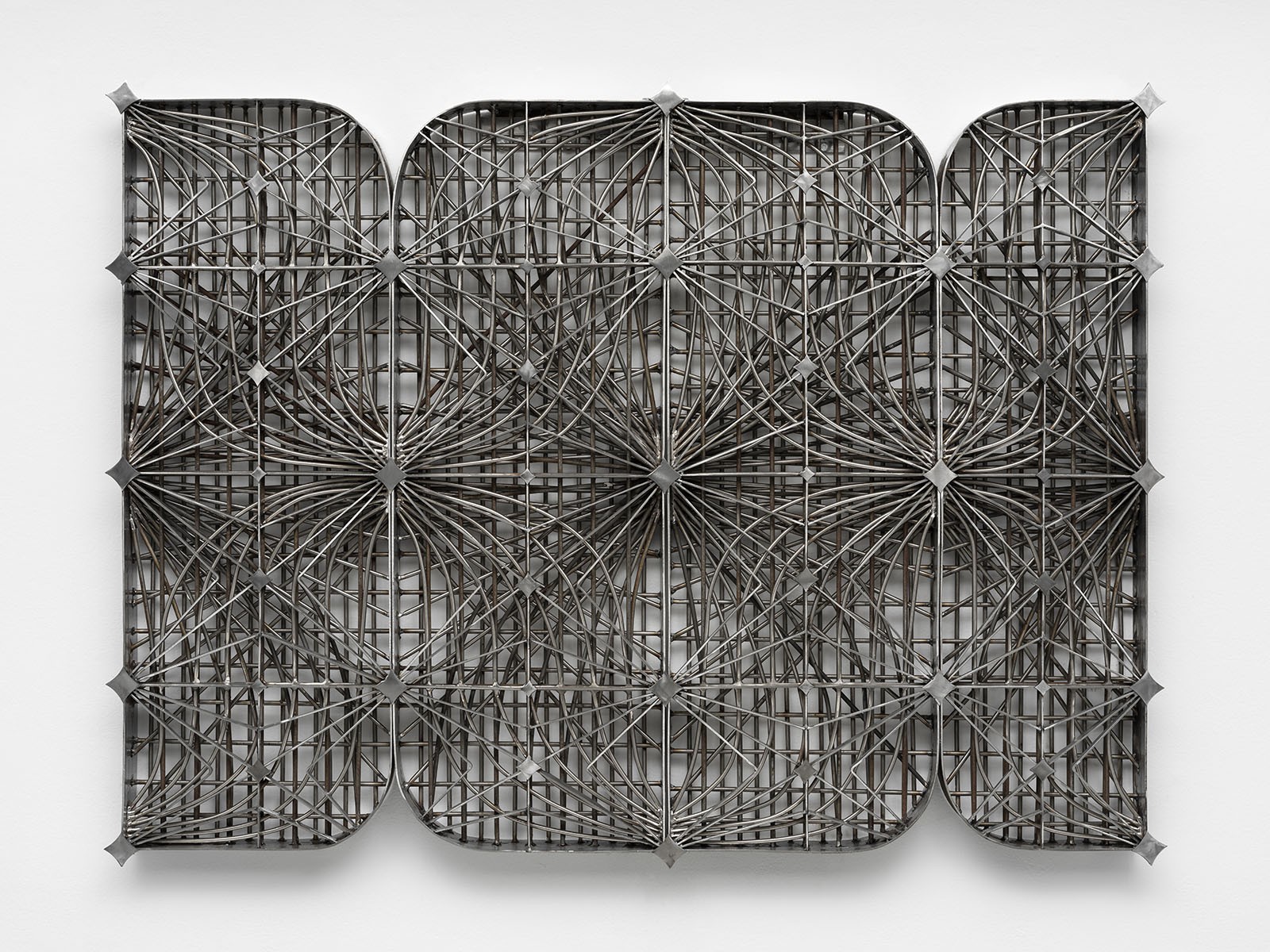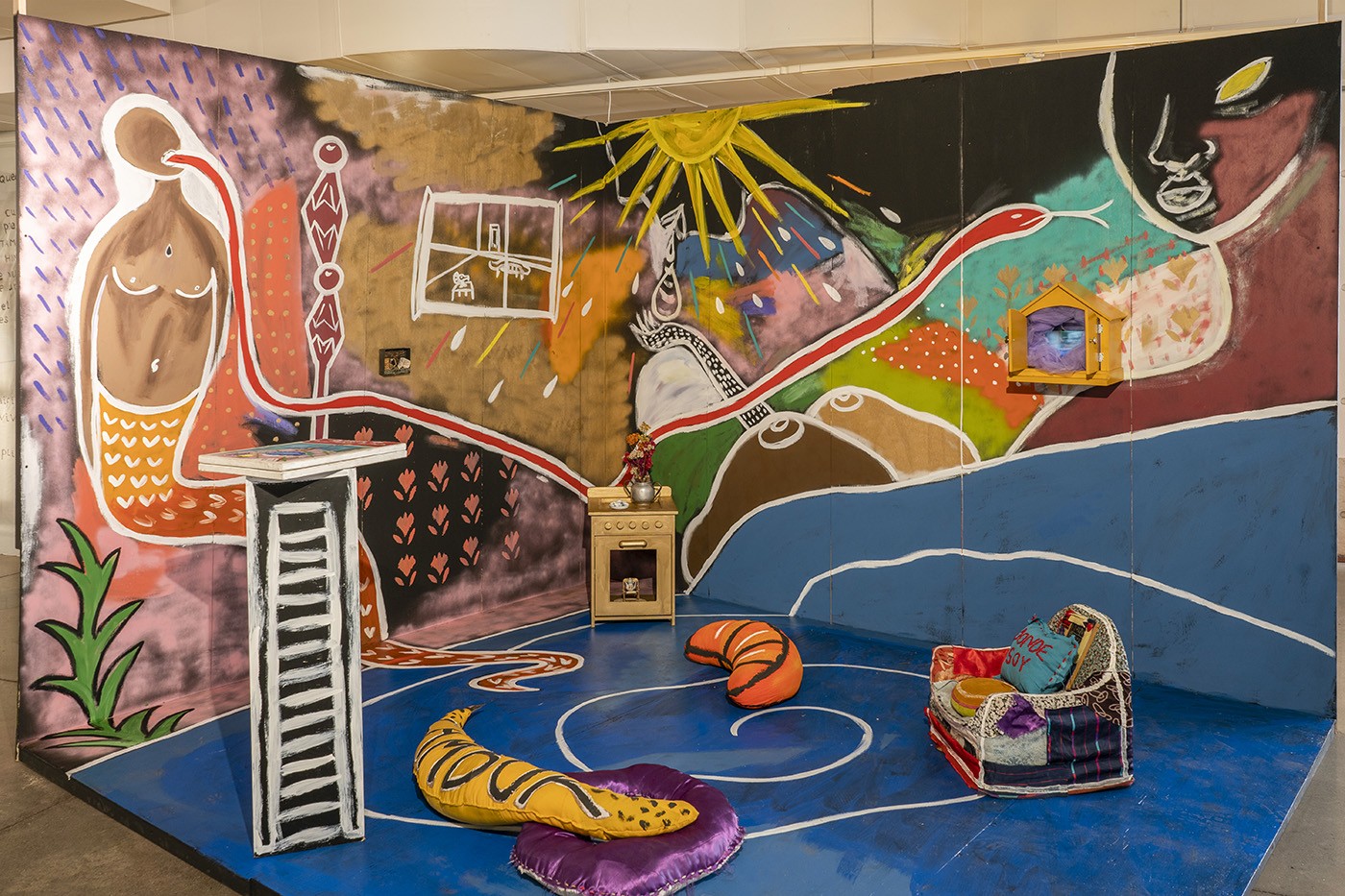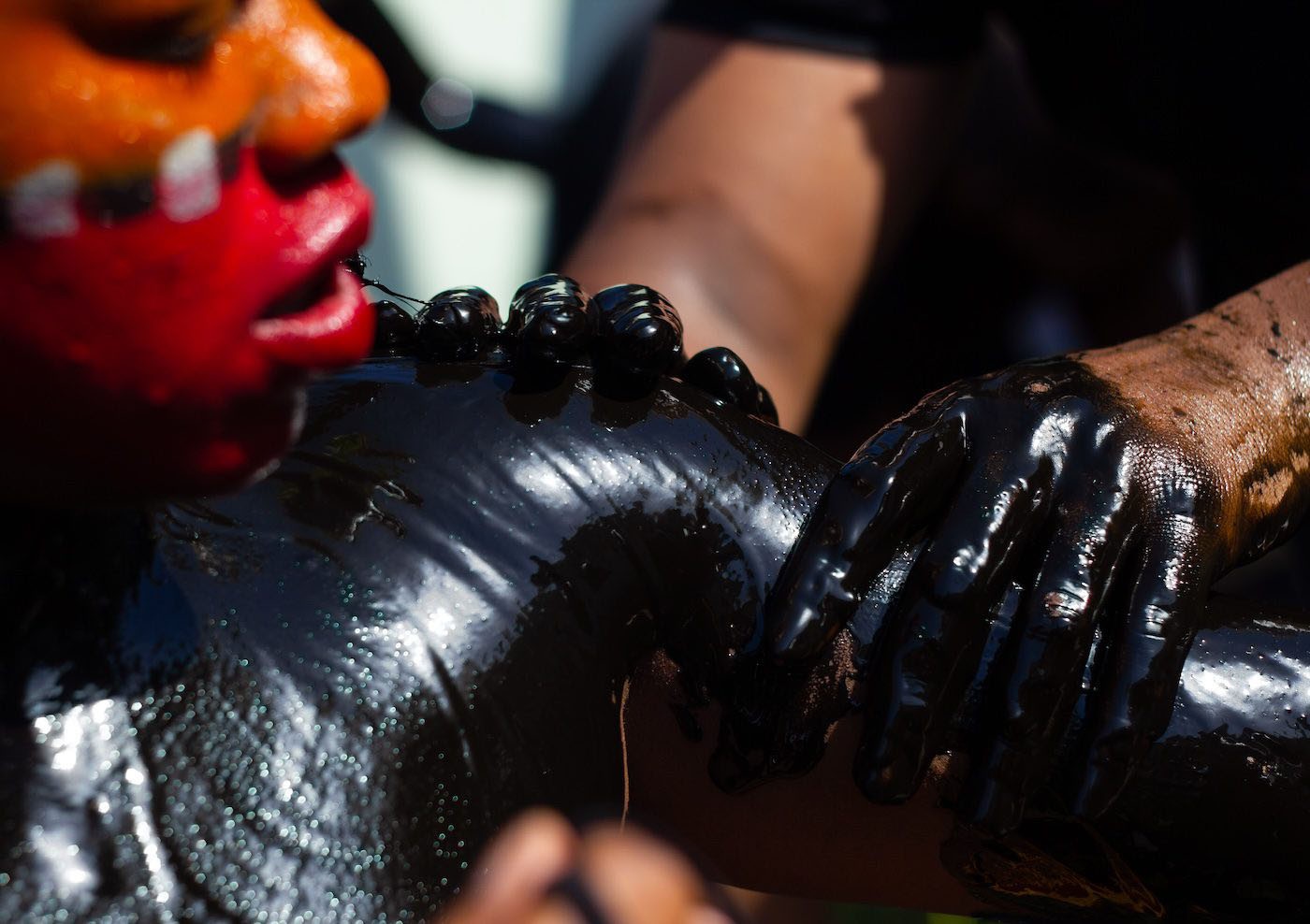Issa Samb: ‘An artist doesn't need to go anywhere. Creating art is being. You can be wherever you are.’
22 May 2013
Magazine C& Magazine
Words Fadlabi
10 min read
ʻWORD! WORD? WORD! Issa Samb and the Undecipherable Formʼ is the first solo exhibition in Europe by the seminal Senegalese artist Issa Samb. The Sudanese artist Fadlabi, based in Oslo, met Samb for an interview.
The first time I saw Issa Samb was in Dakar. I was there among others discussing the establishment of art institutions in Africa. Most of those attending the symposium were not Africans. Samb was sitting in the first row, listening carefully, mostly with his headset on, to the translation from English to French. Sometimes he would stand suddenly, walk to the podium and fill the glasses of the speakers with water. He would bow and gesture that he was welcoming them. It felt like Dakar was his home and we were all his guests. Issa Samb moves in a theatrical way, slowly and elegantly, as if he is trying not to make a sound. He is also very calm when he speaks. Tall, as most of the Senegalese, and extremely slim. He always wears a beret, like an old French painter, his tousled grey hair showing from beneath it. He also wears a long, multi-coloured coat that one doesn’t know if it's a western coat or a dervish dress from a Sufi mosque.
We are in Oslo now. Samb and I are sitting in his exhibition 'WORD! WORD? WORD!' at the Office for Contemporary Art Norway. He is sitting on the sofa in the corner of the gallery space where he has arranged what looks like a living room, with a sofa, two armchairs, one of them covered with a multitude of colourful teddy bears sewed to its cover. In front of us is a table with a TV monitor playing some video. The images in the video seem to be old and dusty, like the rest of the exhibition. The show seems to be made up of things he has collected in the course of several years, while living on the outskirts of some crowded city. Almost everything is covered with dust, some things are covered with dry leaves and cobwebs. When taking a closer look at the objects filling the gallery space, you will find almost anything: paintings, sculptures, cloth, x-ray scans, stacks of old newspapers and many other objects. The striking thing about this chaos is the calm energy the objects convey. They actually make you think! Looking at them, I thought about death, time, religion, economy, good and evil, and sometimes I saw Dakar again. In the middle of the gallery floor lies what looks like a very tall dead man wrapped in white cloth. On top of him Samb has placed four wooden crosses. By the dead man’s head stands a huge cross that penetrates the space, all the way from the floor until it touches the very high ceiling. The most disturbing image for me were the nails Samb had stuck into some plastic baby dolls. He stuck nails into their faces and bodies. It felt like Issa Samb was torturing himself or complaining about something very painful. The dead man also felt like him. He was tall and calm like Samb himself.
.
Fadlabi: I am not a journalist, so I will ask you about some stuff that I don't know how to answer myself.
Issa Samb nods.
Fadlabi: Is there African art?
Samb: Yes, there is!
Fadlabi: Is it African art or art made by Africans?
Samb: During my stay in Oslo I noticed some aspects and elements in the Norwegian art scene that one can consider as African. And if we mention music, that is not a question at all.
Fadlabi: Is it just aesthetics then, or is there an ideology to it? I mean, seeing elements is not new, you find the same with Picasso and Modigliani.
Samb: It's both. It depends on the artist. The elements we see in the work of Norwegian artists should be considered African and Picasso and Modigliani were also creating African art. When Picasso broke away from impressionism and classism and invented cubism, he did that influenced by African sculptures. If it wasn't for those sculptures, he would have not been able to reach cubism.
Fadlabi: So, you mean there is African art in contemporary art but people don't call it that?
Samb: Yes. It's not normal to use African elements and not call what you create African. It doesn't matter where you come from.
Fadlabi: Do African artists need to come to Europe to make it in the art world?
Samb: An artist doesn't need to go anywhere. Creating art is being. You can be wherever you are.
Fadlabi: Why do African artists relate to Europe more than Africa then, why don't Senegalese artists know about Somali artists and Sudanese artists about Senegalese artists?
Samb: It's not their fault. It's a matter of means of exchange and meeting. If they don't meet, they won't know.
Fadlabi: Do you remember the2nd World Black and African Festival of Arts and Culture (FESTAC) in Lagos in 1977? There are claims that the diplomatic crisis between Senegal and Nigeria then was in fact mirroring the conflict between England and France. It was all about the oil in Biafra.
Samb: It would be too simple to reduce it to a problem between France and England. First of all, that was not the case and secondly, both countries, Senegal and Nigeria, were independent at the time. What happened was that Nigeria had become a dictatorship and the military orchestrated a coup against the organisers of the festival. And that didn't have anything to do with Biafra. Everybody suffered from the war in Biafra but what you are talking about is not related to Biafra. It was a second coup against artists, intellectuals and people of reflection.
The forerunner of FESTAC, the 1st World Festival of Negro Arts in Dakar (1er Festival Mondial des Arts Nègres, also called FESMAN) had been organised in 1966 by the Société Africaine de Culture (African Society for Culture), an organisation set up by Alioune Diop and initiated by former President Senghor. It was recognised by the African Union and had offices in each country. Diop organised this festival after two conferences held in Paris and Rome with African writers and artists. FESMAN was the kick-start for the following festivals. Since the organisation was in the hands of intellectuals, Nigeria wanted the military to take over. The African Society for Culture in Lagos appointed Ambroise Mbia, an actor from Cameroon, as secretary general of the festival. When the Nigerian military rejected Mbia and Diop, Senegal protested. It's not about France and England.
Fadlabi: I see some similarities between the Norwegian and the Senegalese art scene when it comes to the amount of support they get in Norway, because it's not just economical support but it's also ideological. In the case of Senegal it was obviously the Négritude, or at least this is how I feel as a Sudanese. I feel that somehow all Senegalese artists were working around that and I wonder if this is going to happen to us in Norway. If we are all going to produce art that supports the official image that Norway promotes of being a peacekeeper and a mediator. What do you think?
Samb: Senegal is a country of culture. Peacekeeping and mediating is a part of our culture as well. And we have been playing that role in Africa from the beginning. Senegal never stopped supporting culture, even in times of economical depression in the 1980s. By awarding scholarships and arranging festivals. It's a part of our cultural DNA.
Fadlabi: So it's not just Senghor?
Samb: Generally, yes it has to do with Senghor since he was the first to do that. And since he was the engineer of the ideology of Négritude. By the way, I personally fought against Négritude. I don't agree with the ideas of that philosophy. I think it's racial and racist. You can see that today in retrospect. Maybe it was an important battle at the time. So, although I do not agree with its principles, I understand its importance. But, my disagreement with it still stands.
Fadlabi: What's your art about?
Samb: I work every day. I have done that for many years and I will always do that. There never passes a day without me working on my art.
Fadlabi: What should I do to be a good artist?
Samb: You don't need to be good. You need to create art. It doesn't matter if it's good or bad. An artist produces art.
?WORD! WORD? WORD! Issa Samb and the Undecipherable Form? is the first solo exhibition in Europe by the seminal Senegalese artist Issa Samb. The exhibition brings together a selection of emblematic works created by Samb over the past 25 years, including paintings, drawings, sculptures, assemblages and installations, as well as objects, artworks made by others and diverse materials he has amassed in his studio in Dakar?s rue Jules Ferry.
In 1974, along with filmmakerDjibril Diop Mambety and a group of artists, writers, musicians, actors and filmmakers, Samb founded the Laboratoire Agit?Art. Its multi-disciplinary actions were directed against the formalism of the École de Dakar, an object-bound movement developed at the National Art School of Dakar and shaped by Léopold Sédar Senghor?s philosophy of négritude. Aiming to depart from this conception into experimentation and agitation, ephemerality rather than permanence, and political and social ideas rather than aesthetic notions, the Laboratoire Agit?Art developed a distinct ?aesthetic of the social?. Audience participation was paramount to the group?s work, as was the privileging of communicative acts over the physical object. Neither utopian nor self-referential, it grounded its actions in the immediate socio-political situation. Today many of the early members have passed away, but the group?s spirit persists, materialised in all of Samb?s work.
From the time of the creation of the Laboratoire Agit?Art, Issa Samb has produced a graspable, yet cryptic and evanescent body of work. It is a body of work that, despite its avant-garde nature, is firmly rooted in African traditions of artistic multiplicity and simultaneity of forms and actions, where the spoken word and performative actions are highly regarded. And in keeping with Samb?s readings of Marxist philosophy and aesthetics, many of his sculptural assemblages take the paradigm of revolutionary movements as their subject matter, suggesting the possibility that the energy of the visual arts can be harnessed in support of the struggles of the weak and disadvantaged.
?WORD! WORD? WORD!?, curated byKoyo Kouoh, presents a selection of works focusing on Samb?s multifaceted individual production, in a performative installation that references Samb?s home studio in Dakar, referred to as 'La Cour' or 'The Yard'. The display will create a fluid system of exchange between the objects, the artist and the audience.
Issa Samb was born in 1945 in Senegal and lives in Dakar. He also co-founded the Gallery TENQ – Village des Arts in Dakar and is the author of numerous plays, poems and essays. A retrospective of his work was held at the National Art Gallery, Dakar in 2010. His work has been included in exhibitions such as dOCUMENTA (13), Kassel, Germany (2012), the Biennale de l’Art Africain Contemporain, Dak’Art, Dakar (2008) and‘Seven Stories of Modern Art in Africa’, Whitechapel Gallery, London, UK (1995).
Fadlabi is a Sudanese artists based in Oslo.
‘WORD! WORD? WORD! Issa Samb and the Undecipherable Form’,The Office for Contemporary Art Norway (OCA), 4 May - 23 June
Read more from

Maktaba Room: Annotations on Art, Design, and Diasporic Knowledge

Irmandade Vilanismo: Bringing Poetry of the Periphery into the Bienal
Read more from

Jesús Hilário-Reyes: Dissolving Notions of Group and Individual

A Biennial that relates sound to space and bodies


